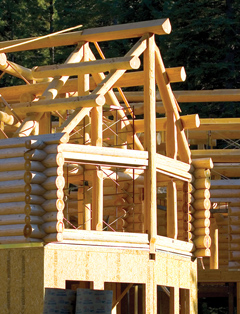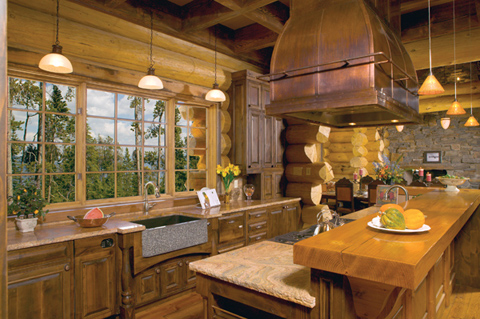The purchase of a log home package is an important step in constructing that home of a lifetime. However, determining the ingredients of the package and finding the right supplier for those necessary items that are not included requires some study and preparation.
“All clients need to be aware that log package prices can be misleading,” relates Jeremy Bertrand, national sales manager for Log Homes of America. “Someone could click on a plan, request a quote, and see a number that is very low for the house they are looking at. It probably only contains a portion of the materials needed to complete the home. The typical log home company provides the shell of the home.”
True enough, most log home packages include basic elements such as the blueprints, wall logs, the majority of the roof system, the second floor system, porch roof system, windows and doors, and the accessories to stack the logs such as fasteners, gaskets, caulking, stain, and splines or dowels.
That means critical pieces of the log home puzzle remain to be procured. These include the foundation, subfloor, interior walls and gable framing, roof covering, floor coverings, deck material, wall coverings, fireplace, mechanical equipment, cabinets, countertops, electrical and plumbing fixtures and installation, and more.
The contents of log packages vary from company to company, and there are several major reasons for this situation. “The single most common reason is that most log manufacturers prefer to supply only what they produce and only the necessary connectors and sealants to assemble their manufactured products,” comments Joe Folker, principal of Timberhaven Log Homes, LLC. “Some log manufacturers supply a partial package to enable them to promote a lower price point.”
Folker recommends that log home shoppers take the time to evaluate their options and then ask questions up front. “The log home company can supply you with as little or as much as you like in your log home package,” he continues. “The main thing you want to keep in mind is that regardless of whether you buy a complete package or a lower priced partial package, you will have to purchase what you need somewhere. So, why not take advantage of the buying power of the log home producer? Narrow your selection of companies down to two or three. Request a detailed estimate so you can see what is included in each package. Then compare quality, completeness of the package, and the services included when assessing the package’s overall value.”

Photo by Dave Wetzel
Most of the items that are not included in the log home package come under the general heading of subcontractor materials. Often, a log company can recommend subcontractors or provide names and contact information for potential sources of materials and installation services. Of course, the consumer can compare prices and quality in determining what to buy and from whom.
“All types of construction involve allowances, such as for excavation, a well, cabinets, flooring, septic, masonry, electrical, and plumbing,” says Tom Wyles, founder and chief executive officer of Tomahawk Log & Country Homes, Inc. “These should be ‘best guesses’ by the general contractor after discussing your plans and listening to what you are after along with the contractor’s experience in what things will probably cost.”
According to Wyles, allowance items are usually those things the homeowner is able to pick and choose such as lighting fixtures, floor coverings, and cabinets, or those with costs that are not completely known until the work is completed, such as the depth of a well or the category of a septic system. The expertise of the contractor is critical here, and the advantage of working with a local builder is tremendous.
“It is commonly recommended that people work with local builders,” advises Bertrand. “If a crew travels from out of state to erect the log package itself, then so be it, but having a local builder to coordinate foundation, sub-floor, and finish work once the erection crew is finished is strongly recommended. Local builders often have relationships with their local building materials companies, meaning they get the best rates in a timely manner.”
Bertrand adds that shopping around for lighting fixtures, floor coverings, fireplaces, and other items can pay off with big savings. References from other log home owners, the chosen builder, the local homebuilders association, and the Internet can provide excellent suggestions for these products.
“Sometimes the best way to be assured that you are getting all that you need to complete your log home is to ask the company that you are considering exactly what is not included in the package, or what you will need to supply to complete the home,” notes Folker. “That way you can avoid any surprises and thoroughly enjoy the building process of your dream home.”
Dedicating time to research prior to investing in a log home package assists the homeowner in making informed decisions and finishing the construction project within budget and with a home to be cherished for years to come.

